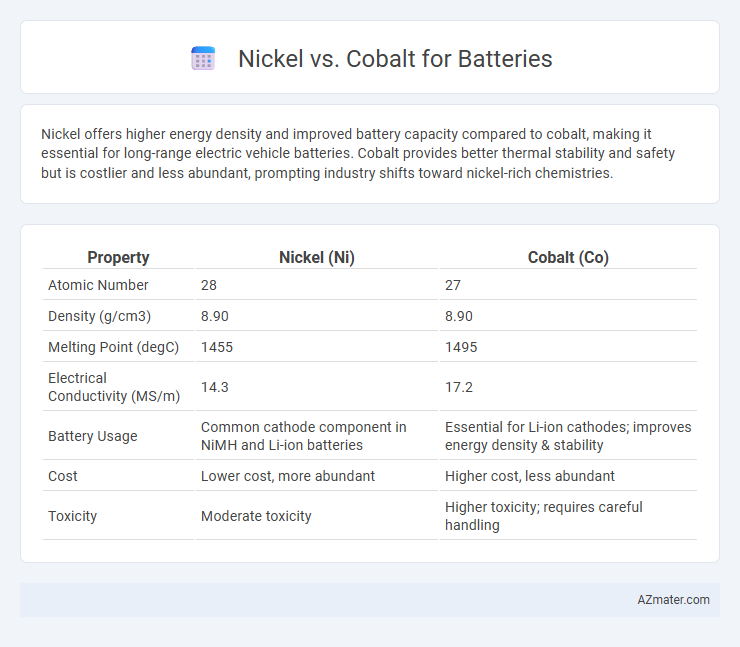Nickel offers higher energy density and improved battery capacity compared to cobalt, making it essential for long-range electric vehicle batteries. Cobalt provides better thermal stability and safety but is costlier and less abundant, prompting industry shifts toward nickel-rich chemistries.
Table of Comparison
| Property | Nickel (Ni) | Cobalt (Co) |
|---|---|---|
| Atomic Number | 28 | 27 |
| Density (g/cm3) | 8.90 | 8.90 |
| Melting Point (degC) | 1455 | 1495 |
| Electrical Conductivity (MS/m) | 14.3 | 17.2 |
| Battery Usage | Common cathode component in NiMH and Li-ion batteries | Essential for Li-ion cathodes; improves energy density & stability |
| Cost | Lower cost, more abundant | Higher cost, less abundant |
| Toxicity | Moderate toxicity | Higher toxicity; requires careful handling |
Introduction to Nickel and Cobalt in Batteries
Nickel and cobalt are critical metals extensively used in lithium-ion batteries, particularly in cathode materials. Nickel enhances energy density and storage capacity, making batteries last longer and charge faster. Cobalt stabilizes the cathode structure, improving battery lifespan and safety by preventing overheating and capacity loss during cycling.
Chemical Properties and Battery Roles
Nickel offers a higher energy density and stability in lithium-ion batteries due to its ability to store more electrons during charge cycles, enhancing capacity and driving range in electric vehicles. Cobalt provides excellent thermal stability and structural integrity by reducing battery degradation and preventing overheating, which improves safety and lifespan. Both elements are critical for battery performance, with nickel boosting capacity and cobalt ensuring durability and reliability under stress.
Energy Density Comparison
Nickel-based batteries typically offer higher energy density compared to cobalt-rich chemistries, making them more suitable for applications demanding longer battery life and increased power storage. The higher nickel content in cathodes enhances the specific capacity and voltage stability, directly boosting the energy density measured in watt-hours per kilogram (Wh/kg). Cobalt contributes to structural stability and safety but at the cost of lower energy density, which is why modern electric vehicle batteries increasingly prioritize nickel to maximize efficiency and driving range.
Cost and Availability
Nickel is generally more abundant and less expensive than cobalt, making it a preferred choice for large-scale battery production. The high cost and limited supply of cobalt have driven manufacturers to seek nickel-rich chemistries, which enhance energy density while reducing overall material expenses. Market volatility and geopolitical factors affecting cobalt availability further emphasize the economic advantage of utilizing nickel in battery cathodes.
Environmental Impact
Nickel extraction generates significant environmental concerns due to high energy consumption and toxic waste, often leading to soil and water contamination. Cobalt mining poses severe ethical and environmental challenges, including habitat destruction and reliance on artisanal mining with poor labor conditions. Sustainable battery production increasingly emphasizes reducing cobalt use while improving nickel processing to minimize ecological footprints.
Safety and Stability Concerns
Nickel-based batteries offer higher energy density but face challenges with thermal stability, increasing the risk of overheating and potential safety hazards. Cobalt enhances battery safety by improving thermal stability and reducing the likelihood of thermal runaway, making cobalt-rich chemistries more stable under stress. Manufacturers balance nickel and cobalt ratios to optimize battery safety without compromising energy performance, with ongoing innovations aimed at minimizing cobalt use while maintaining stability.
Performance in Different Battery Types
Nickel offers higher energy density and improved charge capacity, making it ideal for high-performance lithium-ion batteries such as NMC (Nickel Manganese Cobalt) and NCA (Nickel Cobalt Aluminum) chemistries, which power electric vehicles and portable electronics. Cobalt contributes to battery stability and safety by enhancing thermal stability and cycle life, crucial for batteries in aerospace and critical backup power applications. Balancing nickel's energy benefits with cobalt's safety attributes remains key in optimizing battery performance across diverse industries.
Recycling and Sustainability
Nickel offers higher energy density and cost efficiency but poses significant environmental challenges due to its intensive mining processes, making recycling crucial for sustainability. Cobalt, while essential for battery stability and performance, faces supply chain ethical concerns and scarcity, driving efforts to improve recovery rates and develop recycling technologies. Effective recycling of both metals reduces reliance on virgin materials, lowers carbon footprints, and supports circular economy initiatives in the battery industry.
Industry Trends and Developments
Nickel demand in battery production is surging due to its higher energy density and cost-effectiveness, driving innovations in high-nickel cathode materials for electric vehicles (EVs). Cobalt use is declining amid ethical sourcing concerns and price volatility, prompting the industry to invest in cobalt-free or low-cobalt battery chemistries such as lithium iron phosphate (LFP) and nickel-rich NMC (nickel-manganese-cobalt) variants. Leading battery manufacturers and automakers prioritize increasing nickel content while reducing cobalt dependency to enhance performance and sustainability in next-generation EV batteries.
Future Outlook: Nickel vs Cobalt
Nickel is projected to dominate future battery cathode materials due to its higher energy density and lower cost compared to cobalt. While cobalt offers stability and safety advantages, supply chain bottlenecks and ethical sourcing concerns limit its scalability in large-scale battery production. Innovations in battery chemistry aim to increase nickel content while minimizing cobalt usage, supporting the growing demand for electric vehicles and energy storage systems.

Infographic: Nickel vs Cobalt for Battery
 azmater.com
azmater.com